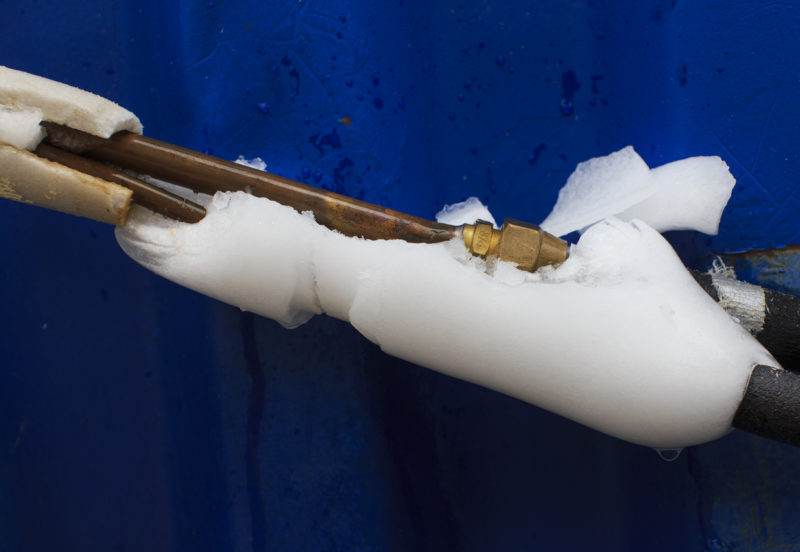Have you been trying to locate advice on How can I fix an air conditioner’s frozen pipe??

Intro
Uncovering that your a/c pipeline is frozen can be concerning, specifically throughout warm summer season when you count on your air conditioning unit the most. Understanding what to do in such a scenario is crucial to stop more damage to your cooling system and guarantee your convenience inside your home.
Understanding the Causes
Several variables can add to the freezing of an AC pipeline. Understanding these causes can aid you attend to the concern properly.
Absence of Airflow
One common reason for a frozen air conditioning pipe is inadequate air flow. When the air flow over the evaporator coil is restricted, it can cause the coil to go down below freezing temperature, causing ice development on the pipeline.
Reduced Refrigerant Levels
Insufficient refrigerant levels in your a/c system can likewise lead to a frozen pipe. Low refrigerant degrees can create the stress in the system to go down, causing the freezing of moisture on the evaporator coil.
Cold Weather Conditions
In cooler environments, freezing temperatures outside can contribute to the cold of a/c pipes. If your AC device is not appropriately protected or if there are leaks in the ductwork, cool air can infiltrate the system, creating the pipe to ice up.
Dirty Air Filters
Dirty or clogged air filters can restrict air movement in your air conditioning system, leading to various problems, consisting of an icy pipeline. It's vital to change or clean your air filterings system regularly to make certain appropriate airflow and protect against ice accumulation.
Signs of a Frozen Air Conditioner Pipe
Acknowledging the signs of an icy air conditioning pipeline is important for punctual action.
Reduced Airflow
If you observe a significant reduction in air movement from your vents, it could indicate an icy pipe.
Ice Buildup on the Pipe
Noticeable ice buildup on the refrigerant line or the evaporator coil is a clear indicator of a frozen air conditioning pipe.
Odd Sounds from the Unit
Uncommon sounds, such as hissing or bubbling, originating from your a/c system can signal that there's ice existing on the pipeline.
Immediate Actions to Take
When faced with an icy air conditioner pipe, it's important to act quickly to prevent additional damage to your air conditioning system.
Switching off the a/c
The initial step is to shut off your air conditioning system to avoid the system from running and aggravating the problem.
Looking for Blockages
Examine the location around the interior unit for any type of blockages that may be blocking air movement, such as furnishings or curtains.
Thawing the Pipe
You can utilize mild approaches like placing towels soaked in warm water around the frozen pipeline to aid thaw it gradually.
Preventive Measures
Taking safety nets can assist stay clear of future incidents of a frozen a/c pipe.
When DIY Methods Fail
If your efforts to thaw the pipe or address other concerns are unsuccessful, it's time to call an expert.
Relevance of Hiring a Professional HVAC Technician
A licensed HVAC professional has the competence and devices necessary to identify and fix concerns with your AC system safely and successfully.
Routine Maintenance Checks
Set up normal upkeep consult an expert HVAC service technician to ensure that your a/c system is running effectively.
Transforming Air Filters
On a regular basis replace or clean your air filters to avoid airflow limitations and keep optimal performance.
Protecting Exposed Pipes
If your AC pipelines are revealed to cold temperatures, take into consideration protecting them to prevent freezing throughout cold weather.
Seeking Professional Help
If DIY methods fall short to deal with the concern or if you're uncertain concerning exactly how to continue, it's best to look for assistance from a certified HVAC technician.
Final thought
Dealing with a frozen a/c pipeline can be an aggravating experience, however recognizing how to respond can help decrease damages and bring back comfort to your home. By recognizing the reasons, acknowledging the indications, and taking punctual activity, you can effectively address the issue and protect against future incidents.
What to Do If Your AC Line Is Frozen
Make Sure All Supply and Return Air Vents Are Open
If you notice problems with airflow, the first thing you should do is check your supply and return vents. Supply vents distribute clean, conditioned air throughout your home. As this air becomes stale, it’s pulled into the return vent, where it’s reconditioned before being sent back out through the supply vent.
When these vents are closed, air won’t flow in the home. Before examining your AC, check the vents in every room and ensure they’re all open.
Check for a Dirty Air Filter
Another possible cause of limited airflow is a dirty air filter. Your air conditioner’s filters catch elements you don’t want to breathe in, such as dirt and dust. Over time, filters can become clogged, ultimately blocking air from flowing in and out. The lack of airflow can then cause the entire coil to freeze and will completely restrict any air from moving through it. The AC may need to be powered off for one to two days to allow the coil to thaw after replacing the filter to allow proper functioning of the unit. This debris can also accumulate on your AC’s evaporator coil, requiring a more serious repair. In general, air filters should be cleaned regularly (about every two weeks).
Assess Your Outdoor Unit
In addition to checking your AC, assessing the outdoor unit is a good idea. Also known as the condensing unit, it works with your interior unit to release heat outside. An issue with the outdoor unit can result in rising internal temperatures.
Overgrown Shrubs or Clogged Leaves
From leaves and twigs to shrubs and debris, there’s no shortage of outdoor elements that can accumulate around your condensing unit. When these elements get lodged inside the unit, they can block airflow. Fortunately, removing the blockage can solve the problem.
Sounds of a Broken Fan
Shrubs and leaves aren’t the only things that can impede your outdoor unit’s airflow. If the fan is broken, the unit won’t be able to properly get rid of heat — which means the internal temperature won’t go down. First, make sure the fan is spinning. If it is, check for the following sounds of a broken fan:
- Buzzing
- Rattling
- Screeching
- Hissing
- Clicking
Preventative Measures
Nobody wants to deal with a frozen AC line. In addition to causing problems with your air conditioner, they require professional repairs. On the bright side, there are preventative measures you can take to help ensure this issue doesn’t arise in the first place.
https://www.coopergreenteam.com/blog/what-to-do-if-ac-line-frozen

We hope you liked our piece about How can I fix an air conditioner’s frozen pipe?. Many thanks for finding the time to browse our short article. Do you know about somebody else who is excited about the subject? Take a moment to share it. Many thanks for your time spent reading it.
Further Details
Comments on “What to Do When Your AC Pipe Gets Frozen: Complete Manual”